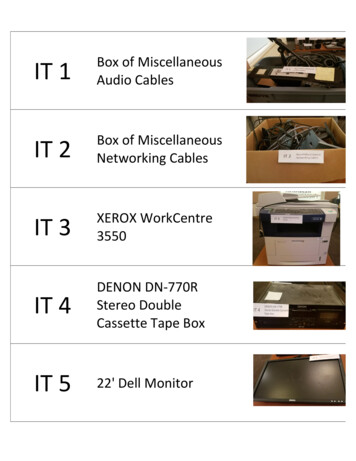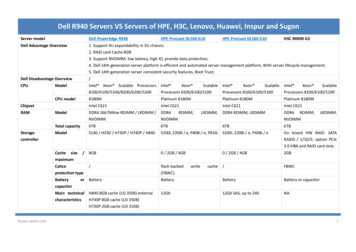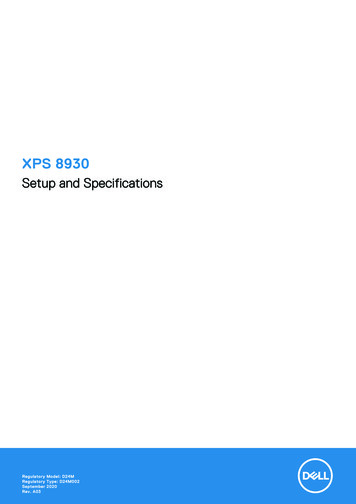
Transcription
Dell E1909W Flat Panel Monitor User's GuideAbout Your MonitorSetting Up the MonitorOperating the MonitorTroubleshootingAppendixNotes, Notices, and CautionsNOTE: A NOTE indicates important information that helps you make better use of your computer.NOTICE: A NOTICE indicates either potential damage to hardware or loss of data and tells you how to avoid the problem.CAUTION: A CAUTION indicates a potential for property damage, personal injury, or death.Information in this document is subject to change without notice. 2008 Dell Inc. All rights reserved.Reproduction in any manner whatsoever without the written permission of Dell Inc. is strictly forbidden.Trademarks used in this text: Dell and the DELL logo are trademarks of Dell Inc; Microsoft a n d Windows are either trademarks or registered trademarks of Microsoft Corporation inthe United States and/or other countries; Adobe is a trademark of Adobe Systems Incorporated, which may be registered in certain jurisdictions. ENERGY STAR is a registeredtrademark of the U.S. Environmental Protection Agency. As an ENERGY STAR partner, Dell Inc. has determined that this product meets the ENERGY STAR guidelines for energyefficiency.Other trademarks and trade names may be used in this document to refer to either the entities claiming the marks and names or their products. Dell Inc. disclaims anyproprietary interest in trademarks and trade names other than its own.Model E1909WcJuly 2008 Rev. A00
Back to Contents PageAbout Your MonitorDell E1909W Flat Panel Monitor User's GuidePackage ContentsProduct FeaturesIdentifying Parts and ControlsMonitor SpecificationsPlug and Play CapabilityMaintenance GuidelinesPackage ContentsYour monitor ships with the components shown below. Ensure that you have received all the components and contact Dell if something is missing.NOTE: Some items may be optional and may not ship with your Monitor. Some features or media may notbe available in certain countries.lMonitorlStandlPower CablelVGA Cable (attached to the monitor)
lDVI CablelDrivers and Documentation mediaQuick Setup GuideSafety InformationllProduct FeaturesThe E1909W flat panel display has an active matrix, thin-film transistor (TFT), liquid crystal display (LCD). The monitor features include: 19-inch (481.4 mm) viewable area display. 1440x900 resolution, plus full-screen support for lower resolutions. Wide viewing angle to allow viewing from a sitting or standing position, or while moving from side-to-side. Tilt capability. Removable pedestal and Video Electronics Standards Association (VESA) 100 mm mounting holes for flexible mounting solutions. Plug and play capability if supported by your system. On-Screen Display (OSD) adjustments for ease of set-up and screen optimization. Software and documentation media which includes an information file (INF), Image color Matching File (ICM), and product documentation. Energy Saver feature for Energy Star compliance. Security lock slot. EPEAT GOLD compliant.Identifying Parts and ControlsFront View
Front panel controlsFront ViewLabel Description1Menu2Adjust up/Brightness & Contrast3Adjust down/Automatic adjust4Select/Input source Select5Power (with power light indicator)Back ViewBack viewLabelBack View with monitor standDescriptionUse1Regulatory rating labelLists the regulatory approvals.2Security lock slotTo help secure your monitor.3Barcode serial number labelTo contact Dell for technical support.4VESA mounting holes (100mm)(Behind attached base plate)To mount the monitor.5Cable management slotTo organize cables by placing them through the slot.6Dell Soundbar mounting bracketsTo attach the optional Dell Soundbar.
Side ViewLeft viewRight viewBottom ViewBottom viewLabel Description1AC power cord connector2DVI connector3VGA connectorMonitor SpecificationsFlat Panel SpecificationsScreen typeActive matrix - TFT LCDScreen dimensions19 inches (19-inch viewable imagesize)Preset display area:408.24(H)X255.15(V)Horizontal408.24 mm (16.08 inches)
Vertical255.15 mm (10.05 inches)Pixel pitch0.2835 mmViewing angle160 (vertical) typical, 160 (horizontal) typicalLuminance output300 CD/m²(typical)Contrast ratio1000 to 1 (typical)Faceplate coatingAntiglare with hard-coating 3HBacklightCCFL (4) edgelight systemResponse Time5 ms typicalColor Gamut82%**[E1909W] color gamut (typical) is based on CIE1976 (82%) and CIE1931 (72%) test standards.
Back to Contents PageAppendixDell E1909W Flat Panel Monitor User's GuideSafety InstructionsFCC Notice (U.S. Only) and Other Regulatory InformationContacting DellCAUTION: Safety InstructionsCAUTION: Use of controls, adjustments, or procedures other than those specified in this documentation may result in exposure to shock,electrical hazards, and/or mechanical hazards.For information on safety instructions, see the Product Information Guide.FCC Notices (U.S. Only) and Other Regulatory InformationFor FCC notices and other regulatory information, see the regulatory compliance website located at www.dell.com\regulatory compliance.Contacting DellFor customers in the United States, call 800-WWW-DELL (800-999-3355).NOTE: If you do not have an active Internet connection, you can find contact information on your purchase invoice, packing slip, bill,or Dell product catalog.Dell provides several online and telephone-based support and service options. Availability varies by country and product, and some services may not beavailable in your area. To contact Dell for sales, technical support, or customer service issues:1.Visit support.dell.com.2.Verify your country or region in the Choose A Country/Region drop-down menu at the bottom of the page.3.Click Contact Us on the left side of the page.4.Select the appropriate service or support link based on your need.5.Choose the method of contacting Dell that is convenient for you.Back to Contents Page
Back to Contents PageSetting Up Your MonitorDell E1909W Flat Panel MonitorIf you have a Dell desktop or a Dell portable computer with internet access1. Go to http://support.dell.com, enter your service tag, and download the latest driver for your graphics card.2. After installing the drivers for your Graphics Adapter, attempt to set the resolution to 1440x900 again.NOTE: If you are unable to set the resolution to 1440x900, please contact Dell to inquire about a Graphics Adapter that supports these resolutions.Back to Contents Page
Back to Contents PageSetting Up Your MonitorDell E1909W Flat Panel MonitorIf you have non Dell desktop, portable computer, or graphic card1. Right-click on the desktop and click Properties.2. Select the Settings tab.3. Select Advanced.4. Identify your graphics controller supplier from the description at the top of the window (e.g. NVIDIA, ATI, Intel etc.).5. Refer to the graphic card provider website for updated driver (for example, http://www.ATI.com OR http://www.NVIDIA.com ).6. After installing the drivers for your Graphics Adapter, attempt to set the resolution to 1440X900 again.NOTE: If you are unable to set the resolution to 1440x900, please contact the manufacturer of your computer or consider purchasing a graphics adapterthat will support the video resolution of 1440x900.Back to Contents Page
Back to Contents PageOperating the MonitorDell E1909W Flat Panel Monitor User's GuideUsing the Front Panel ControlsUsing the On-Screen Display (OSD) MenuSetting the Optimal ResolutionUsing the Dell Soundbar (Optional)Using the TiltUsing the Front PanelUse the control buttons on the front of the monitor to adjust the characteristics of the image being displayed. As you use these buttons to adjust the controls,an OSD shows the numeric values of the characteristics as they change.Front panel ButtonADescriptionUse the MENU button to launch the on-screen display (OSD) and select the OSD Menu. See Accessing the Menu System.MenuBUse this button to directly access the "Brightness/Contrast" menu or to increase the values of the selected menu option.Brightness&Contrast /AdjustUPCUse Auto Adjust to activate automatic setup/adjustment or to decrease the values of the selected menu option. The followingdialog appears on a black screen as the monitor self-adjusts to the current input:Automatic Adjust /AdjustDownAuto Adjustment allows the monitor to self-adjust to the incoming video signal. After using Auto Adjustment, you can furthertune your monitor by using the Pixel Clock (Coarse) and Phase (Fine) controls under Image Settings.NOTE: Auto Adjust does not occur if you press the button while there are no active video input signals or attached cables.DUse this button to select the input source or select an OSD menu option. Use the Input source button to select one of the twodifferent video signals that may be connected to your monitor:lInput Source Select/SelectlVGA inputDVI-D input
ororIf either VGA or DVI-D input is selected and both VGA and DVI-D cables are not connected, a floating dialog box as shown belowappears.orEUse the Power button to turn the monitor on and off.The Blue LED indicates the monitor is on and fully functional. An amber LED indicates DPMS power save mode.Power(with power light indicator)Using the On-Screen Display (OSD) MenuAccessing the Menu SystemNOTE: If you change the settings and then either proceed to another menu or exit the OSD menu, the monitor automatically saves those changes. Thechanges are also saved if you change the settings and then wait for the OSD menu to disappear.1. Push the MENU button to launch the OSD menu and display the main menu.Main Menu for Analog (VGA) InputorMain Menu for non Analog (non VGA) Input
NOTE: AUTO ADJUST is only available when you use the analog (VGA) connector.2. Push theandbuttons to move between the setting options. As you move from one icon to another, the option name is highlighted. See thefollowing table for a complete list of all the options available for the monitor.3. Push the MENU button once to activate the highlighted option.4. Pushandbutton to select the desired parameter.5. Push MENU to enter the slide bar and then use theandbuttons, according to the indicators on the menu, to make your changes.6. Select the "Menu/Exit" option to return to the main menu or exit the OSD menu.IconMenu andDescriptionSubmenusBRIGHTNESS Use this menu to activate Brightness/Contrast adjustment.& CONTRASTBrightnessBrightness adjusts the luminance of the backlight.Push theContrastbutton to increase brightness and push thebutton to decrease brightness (min 0 max 100).Adjust Brightness first, and then adjust Contrast only if further adjustment is necessary.Push thebutton to increase contrast and push thebutton to decrease contrast (min 0 max 100).The Contrast function adjusts the degree of difference between darkness and lightness on the monitor screen.AUTOADJUSTEven though your computer recognizes your monitor on startup, the Auto Adjustment function optimizes the display settings for usewith your particular setup.
NOTE: In most cases, Auto Adjust produces the best image for your configuration.NOTE: AUTO ADJUST option is only available when you are using the analog (VGA) connector.INPUT SOURCEUse the INPUT SOURCE menu to select between different video signals that may be connected to your monitor.VGASelect VGA input when you are using the analog (VGA) connector. Pushto select the VGA input source.Select DVI-D input when you are using the Digital (DVI) connector. Pushto select the DVI input source.DVI-DCOLORSETTINGSUse the Color Settings to adjust the color setting mode and color temperature.There are different color setting sub-menus for VGA/DVI-D and Video input.Input ColorFormatChoose the RGB option if monitor is connected to a PC or a DVD using a VGA or DVI cable. Choose the YPbPr option if monitor isconnected to a DVD by a YPbPr to VGA or YPbPr to DVI cable or if the DVD color output setting is not RGB.ModeSelectionYou can choose Graphics or Video according to the input signal. Select Graphics if connecting a PC to your monitor; for connectingDVD, STB or VCR to your monitor, Video is recommended.Preset ModesWhen you select Graphics, you can choose Standard, Multimedia, Game, Warm, Cool, or Custom (R,G,B);lllllllllIf you view media application like photo, clip etc via PC, choose "Multimedia" preset;If you play a game in PC, choose "Gaming" preset;If you prefer a lower color temperature (5700K), choose "Warm" preset;If you prefer a higher color temperature, choose "Cool" preset;Custom (R, G, B) Preset offers a range of 6500K colors;Choose "Standard" to utilize the panel native color format;Select Warm preset for a reddish tint. This color setting is used for color-intensive applications (photograph image editing,multimedia, movies, etc.)Select Cool preset for a bluish tint. This color setting is used for text based applications (spreadsheets, programming, texteditors, etc.)Select Custom preset to increase or decrease each of the three colors (R, G, B) independently, in single digit increments, from 0to 100.
When you select Video, you can choose Movie, Game, Sports, or Nature preset:lllllFor playing a movie, choose "Movie" preset;For playing a sport program, choose "Sports" preset;For playing a game, choose "Game" preset;For general picture or web or watch TV, choose Nature preset. You can adjust the Hue(Tint)/Saturation based on yourpreference. If you want to restore default color settings, choose Color Reset;Select Color Reset preset to restore default (factory) Color settings. This setting is also the “sRGB” standard default colorspace.HueThis feature can shift color of video image to green or purple. This is used to adjust the desired flesh tone color. Useto adjust the hue from '0' to '100' .Pushto increase the green shade of the video imagePushto decrease the purple shade of the video imageorNOTE: Hue adjustment is available only for video input.SaturationThis feature can adjust the color saturation of the video image. UsePushto increase the monochrome appearance of the video imagePushto decrease the colorful appearance of the video imageNOTE: Saturation adjustment is available only for video input.Reset ColorSettingsReset your monitor color settings to the factory settings.DISPLAYSETTINGSUse the Display Settings to adjust image.orto adjust the saturation from '0' to '100'.
Horizontal PositionUse theorbuttons to adjust image left and right. Minimum is '0' (-). Maximum is '100' ( ).Use theorbuttons to adjust image up and down. Minimum is '0' (-). Maximum is '100' ( ).Vertical PositionSharpnessThis feature can make the image look sharper or softer. UsePixel Clockorto adjust the sharpness from '0' to '100'.The Phase and Pixel Clock adjustments allow you to adjust your monitor to your preference. These settings are accessed through themain OSD menu, by selecting 'Image Settings'.Use theorbuttons to adjust for best image quality.PhaseIf satisfactory results are not obtained using the Phase adjustment, use the Pixel Clock (coarse) adjustment and then use Phase(fine), again.ResetDisplaySettingsSelect this option to restore default display settings.OTHERSETTINGSSelect this option to adjust the settings of the OSD, such as, the languages of the OSD, the amount of time the menu remains onscreen, and so on.LanguageLanguage option to set the OSD display to one of seven languages (English, Espanol, Francais, Deutsch, Portugues,Simplified chineseor Japanese).NOTE: Pixel Clock and Phase Adjustments are only available for "VGA" input.Menu TransparencySelect this option to change the menu transparency by pressingor(Minimum: 0 Maximum: 100).Menu TimerOSD Hold Time: Sets the length of time the OSD will remain active after the last time you pressed a button.Menu LockUse theorbuttons to adjust the slider in 5 second increments, from 5 to 60 seconds.Controls user access to adjustments. When 'Lock' is selected, no user adjustments are allowed. All buttons are locked except themenubutton.NOTE: When the OSD is locked, pressing the menu button takes the user directly to the OSD settings menu, with OSD Lockselected. Select "Unlock" to unlock and allow user access to all applicable settings.DDC/CIDDC/CI (Display Data Channel/Command Interface) allows your monitor parameters (brightness, color balance etc) to be adjustablevia software on your PC. You can disable this feature by selecting "Disable".Enable this feature for best user experience and optimum performance of your monitor.
LCDConditioningHelps reduce minor cases of image retention. Depending on the degree of image retention, the program may take some time to run.You can enable this feature by selecting "Enable".Factory ResetReset all OSD settings to the factory preset values.OSD Warning MessagesWhen the monitor does not support a particular resolution mode you will see the following message:This means that the monitor cannot synchronize with the signal that it is receiving from the computer. See Monitor Specifications for theHorizontal and Vertical frequency ranges addressable by this monitor. Recommended mode is 1440 x 900.You will see the following message before the DDC/CI function is disabled.When monitor enters Power Save mode, the following message appears:Activate the computer and wake up the monitor to gain access to the OSD
If you press any button other than the power button one of the following messages will appear depending on the selected input:VGA/DVI-D inputIf either VGA or DVI-D input is selected and both VGA and DVI-D cables are not connected, a floating dialog box as shown below appears.orSee Solving Problems for more information.Setting the Optimal ResolutionTo set the optimal resolution for the monitor:1.2.3.4.Right-click on the desktop and select Properties.Select the Settings tab.Set the screen resolution to 1440 x 900.Click OK.If you do not see 1440 x 900 as an option, you may need to update your graphics driver. Depending on your computer, complete one of the followingprocedures:llIf you have a Dell desktop or portable computer:¡ Go to support.dell.com, enter your service tag, and download the latest driver for your graphics card.If you are using a non-Dell computer (portable or desktop):¡ Go to the support site for your computer and download the latest graphic drivers.¡ Go to your graphics card website and download the latest graphic drivers.Using the Dell Soundbar (Optional)The Dell Soundbar is a stereo two channel system adaptable to mount on Dell Flat Panel Displays. The Soundbar has a rotary volume and on/off control toadjust the overall system level, a blue LED for power indication, and two audio headset jacks.1.Power/volume control2.Power indicator3.Headphone connectorsUsing the Tilt
TiltWith the built-in pedestal, you can tilt the monitor for the most comfortable viewing angle.NOTE: The stand is detached when the monitor is shipped from the factory.Back to Contents Page
Back to Contents PageSetting Up Your MonitorDell E1909W Flat Panel MonitorSetting the display resolution to 1440X900 (Optimal)For optimal display performance while using the Microsoft Windows operating systems, set the display resolution to 1440 x 900 pixels by performing thefollowing steps:1. Right-click on the desktop and click Properties.2. Select the Settings tab.3. Move the slider-bar to the right by pressing and holding left-mouse button and adjust the screen resolution to 1440 X900.4. Click OK.If you do not see 1440X900 as an option, you may need to update your graphics driver. Please choose the scenario below that best describes thecomputer system you are using, and follow the provided directions:1: If you have a Dell desktop or a Dell portable computer with internet access.2: If you have non Dell desktop, portable computer, or graphic card.Back to Contents Page
Dell E1909W Flat Panel MonitorUser GuideSetting the display resolution to 1440x900(Optimal)Information in this document is subject to change without notice. 2008 Dell Inc. All rights reservedReproduction in any manner whatsoever without the written permission of Dell Inc. is strictly forbidden.Trademarks used in this text: Dell, the DELL logo are trademarks of Dell Inc; Microsoft, Windows, Windows 2000, Windows XP and Windows Vista are registered trademarks ofMicrosoft Corporation; which may be registered in certain jurisdictions. ENERGY STAR is a registered trademark of the U.S. Environmental Protection Agency. As an ENERGY STARpartner, Dell Inc. has determined that this product meets the ENERGY STAR guidelines for energy efficiency.Other trademarks and trade names may be used in this document to refer to either the entities claiming the marks and names or their products. Dell Inc. disclaims anyproprietary interest in trademarks and trade names other than its own.Model E1909WcJuly 2008 Rev. A00
Back to Contents PageSetting Up the MonitorDell E1909W Flat Panel Monitor User's GuideAttaching the StandConnecting the MonitorOrganizing Your CablesAttaching the Soundbar (optional)Removing the StandAttaching the StandNOTE: The stand is detached when the monitor is shipped from the factory.To attach the monitor stand:1.2.3.Place the stand on a flat surfaceFit the groove on the back of the monitor to the two tabs on the upper part of the stand.Lower the monitor so that the monitor mounting area snaps on to or locks on to the stand.Connecting Your MonitorCAUTION: Before you begin any of the procedures in this section, follow the Safety Instructions.To connect your monitor to the computer:1.2.Turn off your computer and disconnect the power cable.Connect either the white (digital DVI-D) or the blue (analog VGA) display connector cable to the corresponding video port on the back of yourcomputer. Do not use both cables on the same computer. Use both the cables only when they are connected to two different computers withappropriate video systems.Connecting the white DVI cable
Connecting the blue VGA cableCAUTION: The Graphics are used for the purpose of illustration only. Appearance of the computer may vary.Organizing Your CablesAfter attaching all necessary cables to your monitor and computer, (See Connecting Your Monitor for cable attachment,) use the cable management slotto organize all cables as shown above.Attaching the Dell Soundbar
NOTICE: Do not use with any device other than Dell Soundbar.NOTE: Soundbar Power Connector 12V DC output is for optional Dell Soundbar only.1.Working from the rear of the monitor, attach the Soundbar aligning the two slots with the two tabs along the bottom rear of the monitor.2.Slide the Soundbar to the left until it snaps into place.3.Connect the soundbar with the power brick.4.Plug the power cable of the brick to a nearby power outlet.5.Insert the lime-green mini stereo plug from the rear of the Soundbar into the computer's audio output jack.Removing the StandNOTE: To prevent scratches on the LCD screen while removing the stand, ensure that the monitor is placed on a clean surface.To remove the stand:1.2.3.Rotate the stand to allow access to the stand release button.Press and hold the Stand release button.Lift the stand up and away from the monitor.Wall Mounting (Optional)Refer to the instructions that come with the base mounting kit. To convert your LCD display from a desk-mounted to a wall-mounted display, do the following:1.2.3.4.5.Verify that the power button is turned Off, then disconnect the power cord.Lay the LCD display face down on a soft cloth.Remove the stand assembly from the back of the LCD display by pressing quick release button.Attach the mounting bracket from the VESA compatible wall mounting kit (100 mm x 100 mm distance). (Screw dimension: M4 x 10mm).Attach the LCD display to the wall, following the instructions in the wall-mounting kit.
NOTE: For use only with UL Listed Wall Mount Bracket with minimum weight/load: 4.44kg.Back to Contents Page
Back to Contents PageTroubleshootingDell E1909W Flat Panel MonitorSelf-TestCommon ProblemsVideo ProblemsProduct Specific ProblemsDell Soundbar ProblemsCAUTION: Before you begin any of the procedures in this section, follow the Safety Instructions.Self-TestYour monitor provides a self-test feature that allows you to check whether your monitor is functioning properly. If your monitor and computer are properlyconnected but the monitor screen remains dark, run the monitor self-test by performing the following steps:1.2.3.Turn off both your computer and the monitor.Unplug the video cable from the back of the computer. To ensure proper Self-Test operation, remove both Digital (white connector) and the Analog (blueconnector) cables from the back of computer.Turn on the monitor.The floating dialog box should appear on-screen (against a black background) if the monitor cannot sense a video signal and is working correctly.While in self-test mode, the power LED remains green. Also, depending upon the selected input, one of the dialogs shown below will continuouslyscroll through the screen.or4.5.This box also appears during normal system operation, if the video cable becomes disconnected or damaged.Turn off your monitor and reconnect the video cable; then turn on both your computer and the monitor.If your monitor screen remains blank after you use the previous procedure, check your video controller and computer, because your monitor is functioningproperly.NOTE: Self test feature check is not available for S-Video, Composite, and Component video modes.Built-in DiagnosticsYour monitor has a built-in diagnostic tool that helps you determine if the screen abnormality you are experiencing is an inherent problem with your monitor, orwith your computer and video card.NOTE: You can run the built-in diagnostics only when the video cable is unplugged and the monitor is in self-test mode.To run the built-in diagnostics:1.2.Ensure that the screen is clean (no dust particles on the surface of the screen).Unplug the video cable(s) from the back of the computer or monitor. The monitor then goes into the self-test mode.3.4.Press and hold theandbuttons on the front panel, simultaneously for 2 seconds. A gray screen appears.Carefully inspect the screen for abnormalities.5.6.7.Press thebutton on the front panel again. The color of the screen changes to red.Inspect the display for any abnormalities.Repeat steps 5 and 6 to inspect the display in green, blue, and white colored screens.The test is complete when the white screen appears. To exit, press thebutton again.If you do not detect any screen abnormalities upon using the built-in diagnostic tool, the monitor is functioning properly. Check the video card and computer.Common Problems
The following table contains general information about common monitor problems you might encounter and the possible solutions.Common SymptomsNo Video/Power LED offWhat You ExperienceNo picturelllNo Video/Power LED onNo picture or no brightnessllllPoor FocusPicture is fuzzy, blurry, orghostinglllllShaky/Jittery VideoWavy picture or fine movementlllllMissing PixelsLCD screen has spotslllStuck-on PixelsLCD screen has bright spotslllBrightness ProblemsPicture too dim or too brightlllGeometric DistortionScreen not centered correctlylllPossible SolutionsEnsure that the video cable connecting the monitor and the computer is properlyconnected and secure.Verify that the power outlet is functioning properly using any other electrical equipment.Ensure that the power button is depressed fully.Increase brightness & contrast controls via OSD.Perform monitor self-test feature check.Check for bent or broken pins in the video cable connector.Run the built-in diagnostics.Perform Auto Adjust via OSD.Adjust the Phase and Pixel Clock controls via OSD.Eliminate video extension cables.Reset the monitor to Factory Settings.Change the video resolution to the correct aspect ration (16:10).Perform Auto Adjust via OSD.Adjust the Phase and Pixel Clock controls via OSD.Reset the monitor to Factory Settings.Check environmental factors.Relocate the monitor and test in another room.Cycle power on-off.Pixel that is permanently off is a natural defect that can occur in LCD technology.Run the built-in diagnostics.Cycle power on-off.Pixel that is permanently off is a natural defect that can occur in LCD technology.Run the built-in diagnostics.Reset the monitor to Factory Settings.Auto Adjust via OSD.Adjust brightness & contrast controls via OSD.Reset the monitor to Factory Settings.Auto Adjust via OSD.Adjust brightness & contrast controls via OSD.NOTE: When using '2: DVI-D', the positioning adjustments are not available.Horizontal/Vertical LinesScreen has one or more linesllllllReset the monitor to Factory Settings.Perform Auto Adjust via OSD.Adjust Phase and Pixel Clock controls via OSD.Perform monitor self-test feature check and determine if these lines are also in self-testmode.Check for bent or broken pins in the video cable connector.Run the built-in diagnostics.NOTE: When using '2: DVI-D', the Pixel Clock and Phase adjustments are not available.Synchronization ProblemsScreen is scrambled or appearstornllllllSafety Related IssuesIntermittent ProblemsVisible signs of smoke orsparkslMonitor malfunctions on & offllllMissing ColorPicture missing colorlllWrong ColorPicture color not goodllllImage retention from a static Faint shadow from the staticimage left on the monitor for a image displayed appears onlong period of timethe screenProduct Specific ProblemsllReset the monitor to Factory Settings.Perform Auto Adjust via OSD.Adjust Phase and Pixel Clock controls via OSD.Perform monitor self-test feature check to determine if the scrambled screen appears inself-test mode.Check for bent or broken pins in the video cable connector.Restart the computer in the safe mode.Do not perform any troubleshooting steps.Contact Dell immediately.Ensure that the video cable connecting the monitor to the computer is connectedproperly and is secure.Reset the monitor to Factory Settings.Perform monitor self-test feature check to determine if the intermittent problem
2 Security lock slot To help secure your monitor. 3 Barcode serial number label To contact Dell for technical support. 4 VESA mounting holes (100mm) (Behind attached base plate) To mount the monitor. 5 Cable management slot To organize cables by placing them through the slot. 6 Dell Soundbar mounting brackets To attach the optional Dell Soundbar.










